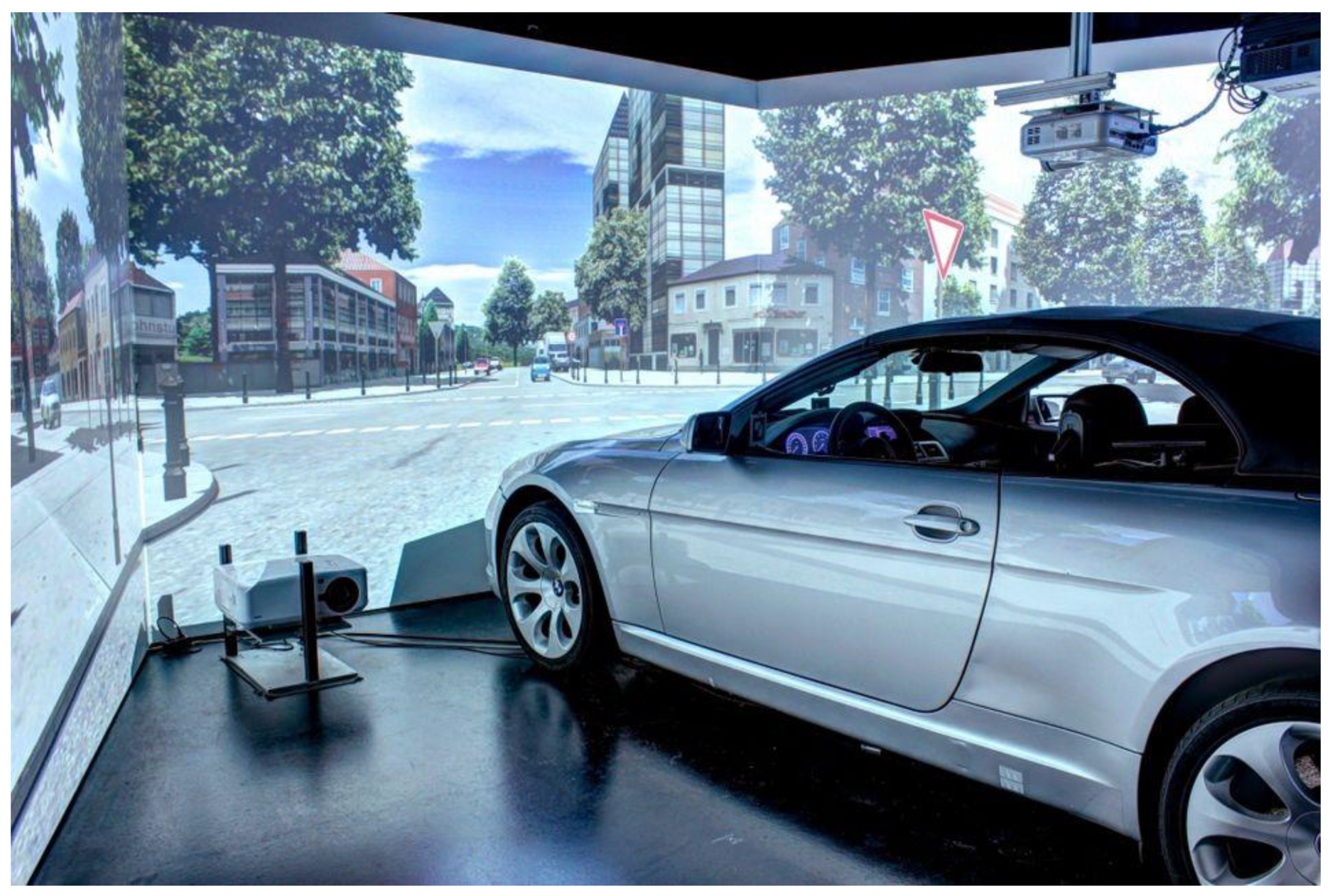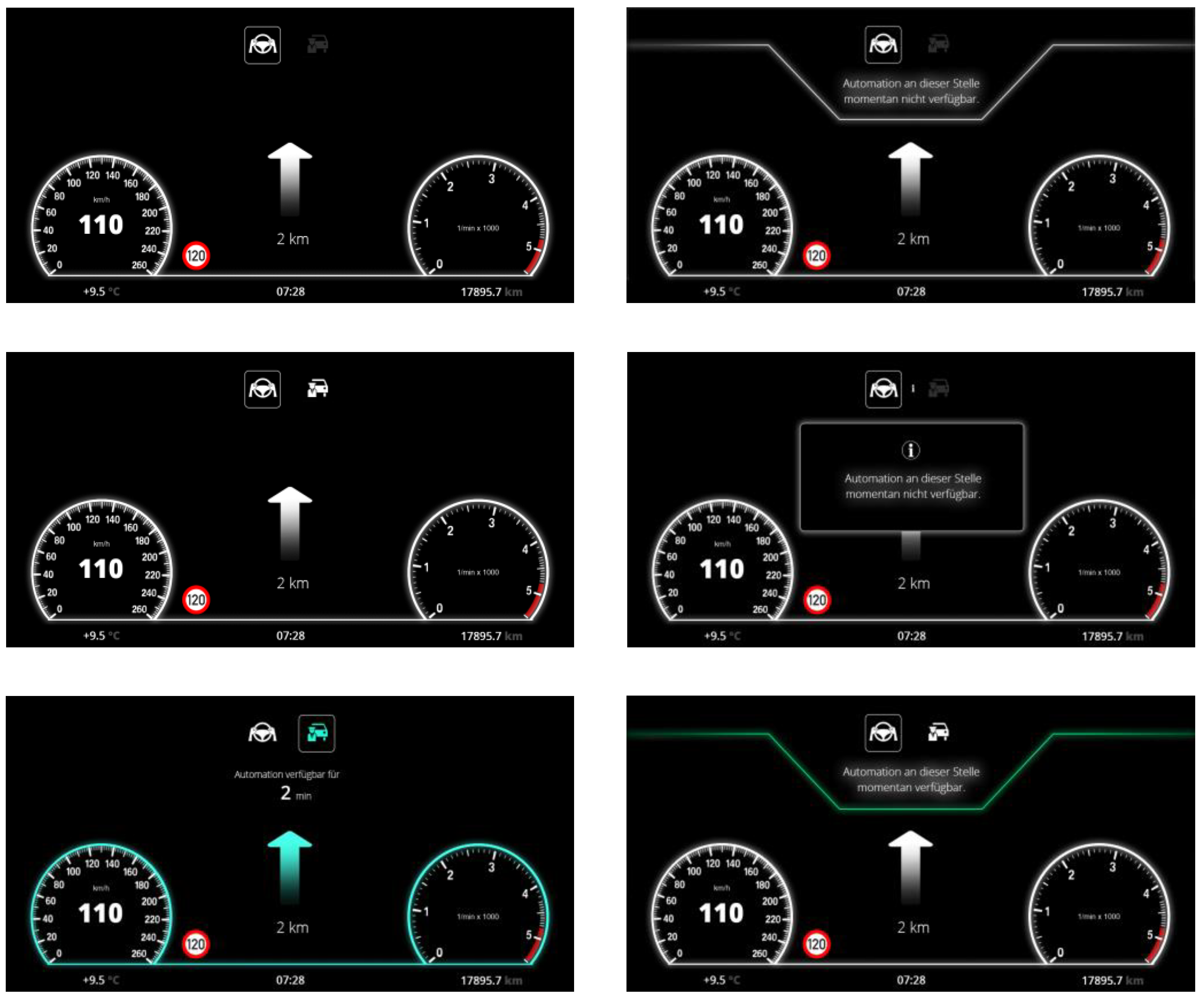Context-Adaptive Availability Notifications for an SAE Level 3 Automation
Abstract
1. Introduction
1.1. Motivation
1.2. Background: Context-Adaptive HMIs
2. Research Objectives and Hypotheses
3. Materials and Methods
3.1. Study Design
3.2. Procedure
3.3. Driving Simulator and Test Track
3.4. Human Machine Interface
3.5. Dependent Variables and Measurement Methods
3.6. Study Sample
3.7. Statistical Analysis
4. Results
4.1. Subjective Data
4.2. Objective Data
4.3. Qualitative Data
5. Discussion and Limitations
Author Contributions
Funding
Institutional Review Board Statement
Informed Consent Statement
Data Availability Statement
Conflicts of Interest
References
- Society of Automotive Engineers. Taxonomy and Definitions for Terms Related to Driving Automation Systems for On-Road Motor Vehicles (J3016_201806); SAE: Warrendale, PA, USA, 2018. [Google Scholar]
- Howard, D.; Dai, D. Public Perceptions of Self-driving Cars: The Case of Berkeley, California. In Proceedings of the 93rd Annual Meeting TRB, Washington, DC, USA, 19 December 2013. [Google Scholar]
- Schoettle, B.; Sivak, M. Public Opinion about Self-Driving Vehicles in China, India, Japan, the US, the UK, and Australia; University of Michigan Transportation Research Institute: Ann Arbor, MI, USA, 2014. [Google Scholar]
- Danner, S.; Pfromm, M.; Limbacher, R.; Bengler, K. Information needs regarding the purposeful activation of automated driving functions—An exploratory study. In Proceedings of the Human Factors and Ergonomics Society Europe Chapter 2019 Annual Conference, Nantes, France, 2–4 October 2019. [Google Scholar]
- Pfleging, B.; Rang, M.; Broy, N. Investigating User Needs for Non-Driving-Related Activities During Automated Driving. In Proceedings of the 15th International Conference on Mobile and Ubiquitous Multimedia—MUM ’16, Rovaniemi, Finland, 12–15 December 2016; Häkkila, J., Ojala, T., Eds.; ACM Press: New York, NY, USA, 2016; pp. 91–99, ISBN 9781450348607. [Google Scholar]
- Schoettle, B.; Sivak, M. A Survey of Public Opinion about Autonomous and Self—Driving Vehicles in the USA, the UK, and Australia; Transportation Research Institute (UMTRI): Ann Arbor, MI, USA, 2014. [Google Scholar]
- Hecht, T.; Feldhütter, A.; Draeger, K.; Bengler, K. What do you do? An analysis of non-driving related activities during a 60 minutes conditionally automated highway drive. In Human Interaction and Emerging Technologies; Ahram, T., Taiar, R., Colson, S., Choplin, A., Eds.; Springer International Publishing: Cham, Switzerland, 2020; pp. 28–34. ISBN 978-3-030-25628-9. [Google Scholar]
- Danner, S.; Pfromm, M.; Bengler, K. Does Information on Automated Driving Functions and the Way of Presenting It before Activation Influence Users’ Behavior and Perception of the System? Information 2020, 11, 54. [Google Scholar] [CrossRef]
- Norman, D.A. Some observations on mental models. In Readings in Human-Computer Interaction: A Multidisciplinary Approach; Baecker, R.M., Buxton, W.A.S., Eds.; Kaufmann: Los Altos, CA, USA, 1987; pp. 241–244. ISBN 0934613249. [Google Scholar]
- Kieras, D.E.; Bovair, S. The Role of a Mental Model in Learning to Operate a Device. Cogn. Sci. 1984, 8, 255–273. [Google Scholar] [CrossRef]
- Kazi, T.A.; Stanton, N.A.; Walker, G.H.; Young, M.S. Designer driving: Drivers’ conceptual models and level of trust in adaptive cruise control. Int. J. Veh. Des. 2007, 45, 339. [Google Scholar] [CrossRef]
- Zwaan, R.A.; Radvansky, G.A.; Hilliard, A.E.; Curiel, J.M. Constructing Multidimensional Situation Models during Reading. Sci. Stud. Read. 1998, 2, 199–220. [Google Scholar] [CrossRef]
- Beggiato, M.; Krems, J.F. The evolution of mental model, trust and acceptance of adaptive cruise control in relation to initial information. Transp. Res. Part F Traffic Psychol. Behav. 2013, 18, 47–57. [Google Scholar] [CrossRef]
- Stanton, N.A.; Young, M.S. A proposed psychological model of driving automation. Theor. Issues Ergon. Sci. 2000, 1, 315–331. [Google Scholar] [CrossRef]
- Beggiato, M.; Hartwich, F.; Schleinitz, K.; Krems, J.; Othersen, I.; Petermann-Stock, I. What would drivers like to know during automated driving? Information needs at different levels of automation. In Proceedings of the 7th Conference on Driver Assistance, Lyon, France, 21 April 2015. [Google Scholar] [CrossRef]
- Carsten, O.; Martens, M.H. How can humans understand their automated cars? HMI principles, problems and solutions. Cogn. Technol. Work. 2018, 21, 3–20. [Google Scholar] [CrossRef]
- Ochs, M.; Pelachaud, C.; Sadek, D. An Empathic Virtual Dialog Agentto Improve Human-Machine Interaction. In Proceedings of the 7th International Joint Conference on Autonomous Agents and Multiagent Systems; Padgham, L., Ed.; International Foundation for Autonomous Agents and Multiagent Systems: Cambridge, MA, USA, 2008; Volume 1, pp. 89–96, ISBN 9780981738109. [Google Scholar]
- Braun, M.; Schubert, J.; Pfleging, B.; Alt, F. Improving Driver Emotions with Affective Strategies. Multimodal Technol. Interact. 2019, 3, 21. [Google Scholar] [CrossRef]
- Bengler, K.; Rettenmaier, M.; Fritz, N.; Feierle, A. From HMI to HMIs: Towards an HMI Framework for Automated Driving. Information 2020, 11, 61. [Google Scholar] [CrossRef]
- Abowd, G.D.; Abowd, G.D.; Dey, A.K.; Dey, A.K.; Brown, P.J.; Brown, P.J.; Davies, N.; Davies, N.; Smith, M.E.; Smith, M.E.; et al. Towards a better Understanding of Context and Context-Awareness. In Proceedings of the International Symposium on Handheld and Ubiquitous Computing, Karlsruhe, Germany, 27–29 September 1999; Springer: Berlin/Heidelberg, Germany, 1999; pp. 304–307. [Google Scholar]
- Fahrmair, M.R. Kalibrierbare Kontextadaption für Ubiquitous Computing. Master’s Thesis, Technische Universität München, München, Germany, 2005. [Google Scholar]
- Garzon, S.R. Kontextsensitive Personalisierung Automotiver Benutzerschnittstellen: Entwicklung und Anwendung eines Regelbasierten Verfahrens zur Erkennung Situationsabh ängiger Mensch-Maschine-Interaktionen. Master’s Thesis, Technischen Universität Berlin, Berlin, Germany, 2013. [Google Scholar]
- Jöst, M. Adapting to the user. In Ubiquitous and Pervasive Computing: Concepts, Methodologies, Tools, and Applications; Symonds, J., Ed.; Information Science Reference: Hershey, PA, USA, 2010; pp. 1006–1020. ISBN 9781605669601. [Google Scholar]
- Schmidt, A.; Beigl, M.; Gellersen, H.-W. There is more to context than location. Comput. Graph. 1999, 23, 893–901. [Google Scholar] [CrossRef]
- Cheverst, K.; Davies, N.; Mitchell, K.; Efstratiou, C. Using Context as a Crystal Ball: Rewards and Pitfalls. Pers. Ubiquitous Comput. 2001, 5, 8–11. [Google Scholar] [CrossRef]
- Hoch, S. Kontextmanagement und Wissensanalyse imkognitiven Automobil der Zukunft. Ph.D. Thesis, Technische Universität München, München, Germany, 2008. [Google Scholar]
- Walter, N. Personalization and Context-Sensitive User Interaction of In-Vehicle Infotainment Systems. Master’s Thesis, Technische Universität München, München, Germany, 2018. [Google Scholar]
- Bader, R.; Wörndl, W.; Prinz, V. Situation Awareness for Proactive In-Car Recommendations of Points-Of-Interest (POI). 2010. Available online: https://www.semanticscholar.org/paper/Situation-Awareness-for-Proactive-In-Car-of-(-POI-)-Bader-W%C3%B6rndl/bebed06ad1d664f6c1fb424efb523c161b6787d3 (accessed on 26 March 2021).
- Rosario, B.; Lyons, K.; Healey, J. A Dynamic Content Summarization System for Opportunistic Driver Infotainment. In Proceedings of the 3rd International Conference on Automotive User Interfaces and Interactive Vehicular Applications, Salzburg, Austria, 30 November–2 December 2011; Tscheligi, M., Ed.; ACM: New York, NY, USA, 2011; p. 95, ISBN 9781450312318. [Google Scholar]
- Amditis, A.; Andreone, L.; Pagle, K.; Markkula, G.; Deregibus, E.; Rue, M.R.; Bellotti, F.; Engelsberg, A.; Brouwer, R.; Peters, B.; et al. Towards the Automotive HMI of the Future: Overview of the AIDE-Integrated Project Results. IEEE Trans. Intell. Transp. Syst. 2010, 11, 567–578. [Google Scholar] [CrossRef]
- Broy, M.; Leuxner, C.; Sitou, W.; Spanfelner, B.; Winter, S. Formalizing the Notion of Adaptive System Behavior. In Proceedings of the 24th Annual ACM Symposium on Applied Computing 2009, Honolulu, HI, USA, 8–12 March 2009; Shin, S.Y., Ossowski, S., Eds.; ACM: New York, NY, USA, 2009; p. 1029, ISBN 9781605581668. [Google Scholar]
- International Organization for Standardization. Ergonomics of Human-System Interaction—Part 11: Usability: Definitions and Concepts, 2018 (ISO 9241-11); ISO: Geneva, Switzerland, 2018. [Google Scholar]
- Adell, E.; Várhelyi, A.; Nilsson, L. The Definition of Acceptance and Acceptability. In Driver Acceptance of New Technology; Apple Academic Press: Palm Bay, FL, USA, 2018; pp. 11–22. ISBN 9781315578132. [Google Scholar]
- Davis, F.D. Perceived Usefulness, Perceived Ease of Use, and User Acceptance of Information Technology. MIS Q. 1989, 13, 319–340. [Google Scholar] [CrossRef]
- Venkatesh, V.; Davis, F.D. A Theoretical Extension of the Technology Acceptance Model: Four Longitudinal Field Studies. Manag. Sci. 2000, 46, 186–204. [Google Scholar] [CrossRef]
- Lin, C.-C. Exploring the relationship between technology acceptance model and usability test. Inf. Technol. Manag. 2013, 14, 243–255. [Google Scholar] [CrossRef]
- François, M.; Osiurak, F.; Fort, A.; Crave, P.; Navarro, J. Automotive HMI design and participatory user involvement: Review and perspectives. Ergonomics 2016, 60, 541–552. [Google Scholar] [CrossRef]
- Schömig, N.; Wiedemann, K.; Naujoks, F.; Hergeth, S.; Keinath, A.; Neukum, A. How important is the plausibility of test scenarios within usability studies for AV HMI? In Advances in Human Aspects of Transportation; Stanton, N., Ed.; Springer International Publishing: Cham, Switzerland, 2020; pp. 77–84. ISBN 978-3-030-50942-2. [Google Scholar]
- Feierle, A.; Danner, S.; Steininger, S.; Bengler, K. Information Needs and Visual Attention during Urban, Highly Automated Driving—An Investigation of Potential Influencing Factors. Information 2020, 11, 62. [Google Scholar] [CrossRef]
- Feierle, A.; Holderied, M.; Bengler, K. Evaluation of Ambient Light Displays for Requests to Intervene and Minimal Risk Ma-neuvers in Highly Automated Urban Driving. In Proceedings of the 2020 IEEE 23rd International Conference on Intelligent Transportation Systems (ITSC), Rhodes, Greece, 20–23 September 2020; IEEE: New York, NY, USA, 2020; pp. 1–8, ISBN 978-1-7281-4149-7. [Google Scholar]
- Muthumani, A.; Diederichs, F.; Galle, M.; Schmid-Lorch, S.; Forsberg, C.; Widlroither, H.; Feierle, A.; Bengler, K. How visual cues on steering wheel improve users’ trust, experience, and acceptance in automated vehicles. In Advances in Human Aspects of Transportation; Stanton, N., Ed.; Springer International Publishing: Cham, Switzerland, 2020; pp. 186–192. ISBN 9783030509422. [Google Scholar]
- Feierle, A.; Bücherl, F.; Hecht, T.; Bengler, K. Evaluation of display concepts for the instrument cluster in urban automated driving. In Human Systems Engineering and Design II; Ahram, T., Karwowski, W., Pickl, S., Taiar, R., Eds.; Springer International Publishing: Cham, Switzerland, 2020; pp. 209–215. ISBN 9783030279271. [Google Scholar]
- Van Der Laan, J.D.; Heino, A.; De Waard, D. A simple procedure for the assessment of acceptance of advanced transport telematics. Transp. Res. Part C Emerg. Technol. 1997, 5, 1–10. [Google Scholar] [CrossRef]
- Brooke, J. SUS: A “quick and dirty” usability scale. In Usability Evaluation in Industry; Jordan, P.W., Thomas, B., McClelland, I.L., Weerdmeester, B., Eds.; Chapman and Hall/CRC: Boca Raton, FL, USA, 1996; ISBN 9780748404605. [Google Scholar]
- Hart, S.G. Nasa-task load index (NASA-TLX); 20 years later. Proc. Hum. Factors Ergon. Soc. Annu. Meet. 2006, 50, 904–908. [Google Scholar] [CrossRef]
- International Organization for Standardization. Road Vehicles—Measurement of Driver Visual Behaviour with Respect to Transport Information and Control Systems—Part 2: Equipment and Procedures. ISO/TS 15007-2:2014; ISO: Geneva, Switzerland, 2014. [Google Scholar]
- Köhler, L.; Bengler, K.; Mergl, C.; Maier, K.; Wimmer, M. Validation of a Telephone Manager for stressful driving situations. In Proceedings of the Human Factors and Ergonomics Society Europe Chapter 2014 Annual Conference: Human Factors in High Reliability Industries, Lisbon, Portugal, 8–10 October 2014; de Waard, D., Sauer, J., Röttger, S., Kluge, A., Manzey, D., Weikert, C., Toffetti, A., Wiczorek, R., Brookhuis, K., Hoonhout, J., Eds.; HFES: Santa Monica, CA, USA, 2015. [Google Scholar]
- Beggiato, M.; Pereira, M.; Petzoldt, T.; Krems, J. Learning and development of trust, acceptance and the mental model of ACC. A longitudinal on-road study. Transp. Res. Part F Traffic Psychol. Behav. 2015, 35, 75–84. [Google Scholar] [CrossRef]




| Day | Availability of ADS | Concept | |||
|---|---|---|---|---|---|
| Highway Segment 1 | Highway Segment 2 | Highway Segment 3 | Group 1 | Group 2 | |
| Monday | Available | Not available | Not available | ||
| Tuesday | Available | Not available | Not available | ||
| Wednesday | Not available | Not available | Available | CA | Not CA |
| Thursday | Available | Not available | Not available | ||
| Friday | Not available | Not available | Available | Not CA | CA |
| Measure | Standard HMI M (SD) | Context-Adaptive HMI M (SD) |
|---|---|---|
| Acceptance (van der Laan) | 0.86 (0.61) | 0.90 (0.75) |
| Usability (SUS) | 87.33 (13.37) | 84.42 (15.78) |
| Frustration (NASA-rTLX) | 4.07 (4.14) | 4.70 (5.17) |
| Measure | Standard HMI M (SD) | Context-Adaptive HMI M (SD) |
|---|---|---|
| Attention Ratio | 14.11% (6.54%) | 16.86% (6.60%) |
| Gaze Frequency | 0.28 (0.10) | 0.30 (0.10) |
| Gaze Duration | 0.52 (0.19) | 0.58 (0.17) |
| Duration until Activation | 14.78 (19.94) | 7.44 (7.58) |
Publisher’s Note: MDPI stays neutral with regard to jurisdictional claims in published maps and institutional affiliations. |
© 2021 by the authors. Licensee MDPI, Basel, Switzerland. This article is an open access article distributed under the terms and conditions of the Creative Commons Attribution (CC BY) license (http://creativecommons.org/licenses/by/4.0/).
Share and Cite
Danner, S.; Feierle, A.; Manger, C.; Bengler, K. Context-Adaptive Availability Notifications for an SAE Level 3 Automation. Multimodal Technol. Interact. 2021, 5, 16. https://doi.org/10.3390/mti5040016
Danner S, Feierle A, Manger C, Bengler K. Context-Adaptive Availability Notifications for an SAE Level 3 Automation. Multimodal Technologies and Interaction. 2021; 5(4):16. https://doi.org/10.3390/mti5040016
Chicago/Turabian StyleDanner, Simon, Alexander Feierle, Carina Manger, and Klaus Bengler. 2021. "Context-Adaptive Availability Notifications for an SAE Level 3 Automation" Multimodal Technologies and Interaction 5, no. 4: 16. https://doi.org/10.3390/mti5040016
APA StyleDanner, S., Feierle, A., Manger, C., & Bengler, K. (2021). Context-Adaptive Availability Notifications for an SAE Level 3 Automation. Multimodal Technologies and Interaction, 5(4), 16. https://doi.org/10.3390/mti5040016






